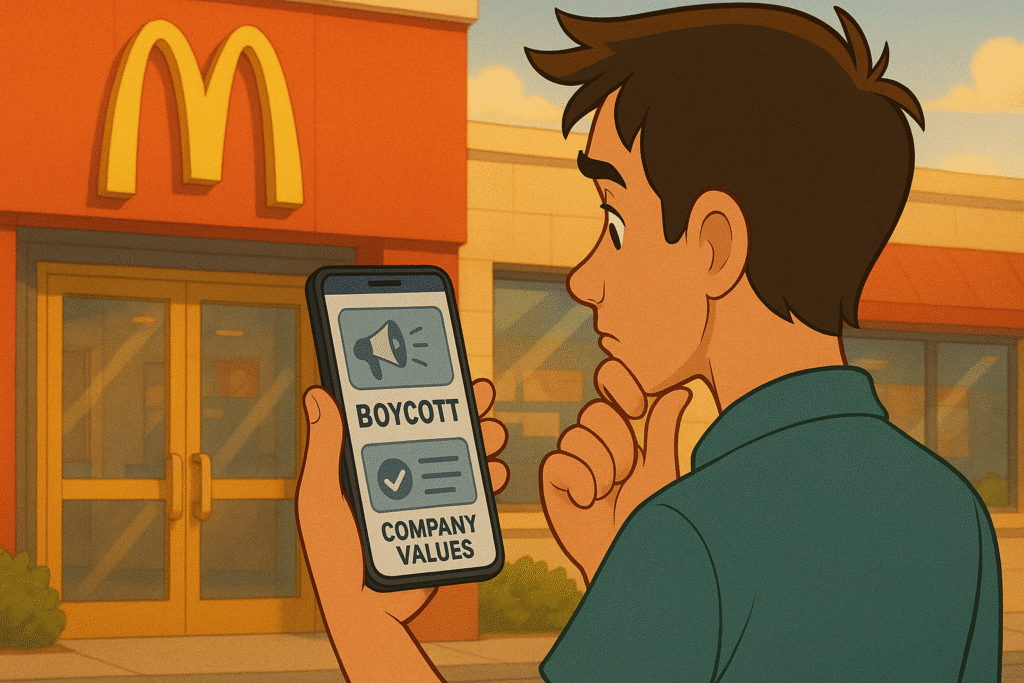
We’re in a new reality where purchasing decisions are political statements
A client texted me yesterday: “Did you see the McDonald’s boycott news? Should we be worried about this kind of thing?”
The short answer:
Yup.
Not because a grassroots boycott will necessarily tank YOUR revenue — some don’t.
But because they tell us something new about how people make purchasing decisions in 2025.
Your customers are NOT only interested in what your product does for them.
They’re checking into (or out of) your values.
McDonald’s is now facing a coordinated boycott over “fair taxes, price gouging, and corporate accountability” — right as they’re dealing with the fallout from 40% price increases since 2019 and TWO consecutive quarters of declining sales.
The timing isn’t coincidental.
When customers already feel financially squeezed, value perception becomes a huge issue.
The people behind the boycott know that better than anyone.
Here’s what product makers need to understand: modern boycotts aren’t simply going off about the stated cause.
They are customers looking for reasons to justify decisions they were already making.
And, often, a special interest group leveraging that tension.
McDonald’s customers were already pulling back due to price sensitivity.
The boycott just gives that behavior a moral framework to use as a rallying cry.
Target learned this lesson expensively. Their 40-day boycott coincided with sales declines, but the company admitted the backlash was about their DEI program reversals — not the boycott organizer’s stated concerns.
The pattern shows up clearly: when customers feel disconnected from your brand values, they become much more price-sensitive and willing to switch.
In I Need That, I discuss how purchasing decisions flip from want to need based on emotional connection. But that same mechanism works in reverse — emotional disconnection makes even habitual purchases feel unnecessary.
And the implications for product makers are big:
Price increases need meaningful value justification. You can’t just cite rising costs anymore. Customers need to believe in your mission AND your value enough to absorb the higher pricing.
Your POSITIONING matters more than your product features. Customers increasingly choose brands that align with their worldview, not just their immediate needs.
Silence becomes a statement. In polarized markets, trying to stay neutral often gets interpreted as taking the opposing side. (Ask Wayne Gretzky.)
Product Payoff: by staying consistent with their environmental values, Patagonia weathered multiple boycott attempts, even when it cost them customers. Their famed “Don’t Buy This Jacket” campaign ironically increased sales because it reinforced authentic brand values. By taking clear positions and accepting that they wouldn’t appeal to everyone, they created deeper loyalty among customers who shared their values — for premium pricing power that pure performance couldn’t achieve.
Your strategic move: Review your brand messaging for unintentional disconnects between stated values and customer experience.
Are your price increases aligned with value delivery?
Do your business practices match your marketing messages?
Are you accidentally alienating customers who should naturally love your product?
The goal is ensuring your brand attracts customers who genuinely need what you offer and share your approach to delivering it.
Are YOU going to participate in the McBoycott?
Have you noticed your own purchasing decisions becoming more values-driven lately?
Hit that reply arrow and share how political or social factors influence your buying choices.
Or reach out to my team of product brand positioning experts at Graphos Product.
